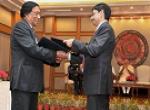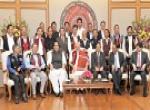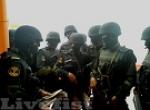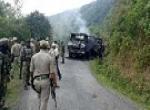One of the most important reasons for the continuance of insurgency in the North East is the region’s proximity to outer lands. The strategic encirclement has not only provided the expanse with a conduit to countries such as China, which welcomed number of insurgent batches from Nagaland, Manipur and Assam, but also bases for training, sustenance and launching pads for operations against India. This has been seen in the case of Myanmar, Nepal, Bangladesh and even Bhutan, the last of which is a country that is a virtual protectorate of India.
Therefore, although the primary motivations for the beginning of an insurgency may range from underdevelopment, social alienation and geographical distance, an important factor that allows an insurgency movement to grow is the presence of efficient conditions by way of a neighbourhood that is either hostile or indifferent to India’s national security interests. The hostile neighbourhood provides insurgent groups waging war with the Indian state a variety of sustenance including the crucial aiding of efforts to internationalising such movements, a move that can be particularly embarrassing for New Delhi. To put the matter of internationalisation into perspective, it was the entry of NSCN (IM) into the Unrepresented Nations and People’s Organisation in January 1993, which met in the Hague, Netherlands, that began the process for a serious political reconciliation move and in July 1997 a ceasefire was signed.
Historically, hostility has showcased itself by way of East Pakistan (and later Bangladesh) and China, with Myanmar providing the corridor for various Indian Insurgent Groups, especially in their efforts to seek aid from the People’s Republic of China. Indeed, the Naga insurgents were the first to reach China, when “some time in January 1967, “Brig” Thinoselie and Muivah with their tired men reached Yunnan” (as retold in Nirmal Nibedon’s Nagaland: Night of the Guerrillas) after a 97 day trek through the inhospitable Myanmarese terrain. Later, the footsteps of the Naga insurgents were to be retraced by ULFA “chief of staff” Paresh Baruah and his “staff officer” Lohit Deury, the latter in his admission to the author on 15 August 2000 after his surrender to the Assam Police provided details about ULFA Missions Lachit and Chilarai to China, when Paresh Baruah met uniformed Chinese officials as well as functionaries of an agency that Deury termed as “Black House”. Research conducted by the author in the aftermath of the admission did not unravel the provenance of “Black House,” but several years later it has come to some light that “Black House” is in all probability a Chinese arms conduiting agency. Also, in Mandarin, “Black House” translates into “Hei Shehui,” which simply means “Black Market.” The arms manufacturing factories of China, primarily the ordnance manufacturing company, Norinco, it is reported, provides the bulk of the weaponry that make up the Indian Insurgent Groups’ arsenal. This is done by selling off the obsolete surplus weaponry, even as PLA shapes itself into a more modern army.
Therefore, Chinese support for Indian Insurgent Groups is part of recorded history, especially in the aftermath of the border war of 1962. But despite the fact that varying observations seem to be of the opinion that China stopped its support to Indian Insurgent Groups since the late-nineteen eighties (which roughly coincided with Rajiv Gandhi’s visit to China in 1988), recent anecdotal accounts seem to state that groups such People’s Liberation Army of Manipur and ULFA have been seen in Yunnan, with at least one report suggesting that ULFA has a “base” in one of Yunnan’s prefectures. ULFA’s need for opening up new channels with China was perhaps necessitated by the crackdown it is facing in Bangladesh, with almost the entire leadership of the organisation being handed over to India by the Bangladesh authorities. Indeed, it was fear of apprehension—in the manner in which other members of his organisation were taken into custody and subsequently handed over to India—that led ULFA “chief of staff” Paresh Baruah to flee to Yunnan, where he is reportedly attempting to revive his floundering organisation. This has become necessary in the face of the almost certain split in ULFA, which is being sought to be engineered by a) releasing the incarcerated leadership of ULFA and b) by expecting the released leaders to come together as an executive council and open a political reconciliation process with the government. The process would almost certainly be leaving out Paresh Baruah, who has made clear his stand against dialogue with the government were it to be without a discussion of “sovereignty of Assam” on the agenda. In a statement emailed to the Press in late December 2010, Baruah has stated that his son was kidnapped in Bangladesh and tortured in order to make him reveal Baruah’s whereabouts, as also to force him to the negotiating table. The intransigence in the enigmatic ULFA strongman can be gauged from the manner in which he made his press statement. He wrote that he was ready to sacrifice his son for the cause of ‘freedom of Assam’ and would never compromise on ULFA’s ‘sovereignty’ demand. The man who visualises himself as a modern day Lachit Barphukan (the Ahom general who successfully fought off the Mughals from Assam) would now be at his belligerence best and would, if necessary, join hands with every conceivable anti-India force, be it the Pakistani ISI, the anti-India lobby in the Bangladesh army and DGFI or the Chinese MSS.
At any rate, the present scenario, by way of the strategic encirclement has changed considerably since the subterfuges that characterised the days when the father of North East insurgency, Angami Zapu Phizo of Khonoma near Kohima first made his way into East Pakistan in the early nineteen-fifties. A pro-Indian Awami League government is in power in Dhaka, and as aforesaid, it has acted against the Indian Insurgent Groups, with (at the time of writing) the last of the important actions being carried out on 25 December 2010, when Bangladesh Border Guards busted ULFA hideouts in Sherpur, which is also the HQ of ULFA’s 109 Battalion. Although the action by Dhaka against ULFA and other Indian Insurgent Groups have been somewhat of a piecemeal affair, with handing-over, camp-busting etc coming in instalments, the fact of the matter is that it is taking place: a Bhutan-style all-encompassing operation is perhaps not possible, primarily because ULFA’s paraphernalia in Bangladesh is scattered throughout the country, and not mainly clustered in one general area that was the case in Bhutan. Moreover, Sheikh Hasina does not yet have complete hold over the Bangladesh army or the DGFI: she is utilising the services of the Detective Branch of the Bangladesh Police as well as the Rapid Action Battalion to combat Islamist militancy, war criminals and the Indian Insurgent Groups. But, it is to her credit that she is doing so despite great odds, and India has much to be grateful for.
But, Myanmar is another story. Indeed, despite the successes of the high level visits between India and Myanmar, the sought for clamping down on the Indian Insurgent Groups is yet to happen. But to be fair to India’s eastern neighbour, Myanmar has not been able to act in the manner that New Delhi has expected it to because many parts of northern and north-western Myanmar are not quite in the control of Naypyidaw. The ethnic groups have considerable influence in the region, and despite the cessation of hostilities between the Myanmarese government and the ethnic groups, many groups have refused to comply with the border guards’ proposal that was mooted by the government, thereby complicating the reconciliation process. Also, there is some reason to believe that the lower echelons of the Myanmarese army have tacit understanding with the Indian Insurgent Groups, and have in the past aided such groups by providing early warning about impending raid via the local population in the region. This results in such groups breaking camp and moving to safer locations.
But, all that may soon change. The two-day 16th Home Secretary Level meeting that began on 30 December – represented by Indian Union Home Secretary, G.K. Pillai and Myanmarese Deputy Minister for Home Affairs, U Phone Swi – saw not only India seeking to sign a Mutual Legal Assistance Treaty (MLAT), but also renewing its call to Myanmar to mount operations against the Indian Insurgent Groups. The MLAT would, it is reported, enhance the ability of the two countries to pursue their common objective of law enforcement, thereby to anvil a legally binding mechanism that would enable law enforcing agencies in both the countries to cooperate and provide assistance to each other on matters relating to investigation, prevention and suppression of crime, including insurgency. It is hoped that with the signing of MLAT, India would be provided with a leverage to pressure Myanmar to decisively act against the Indian Insurgent Groups. Indeed, the accent must now shift to coordinated joint operations, in the manner in which it was undertaken in the mid-nineteen nineties, when Op Golden Bird was put into operations, an operation that resulted in the apprehension of a large number of Indian Insurgent Group cadres and arms and ammunition.
Certain Myanmar and Bangladesh specific recommendations vis-a-vis, possible action against the Indian Insurgent Groups are provided below:
1.As aforesaid, ULFA elements are scattered all over Bangladesh, rendering some difficulty to Dhaka to apprehend/bust such interests in a single swoop. But with the apprehension of important ULFA leaders, information about important names, places and links would have come to light. Although it is certain that such information is being shared with the Bangladesh authorities, a mechanism must be evolved whereby joint operations can be conducted on real time scenarios bypassing traditional channels that would have had to be activated in ordinary circumstances. Institution of such a mechanism would save precious time and would not lead to possibilities of the “bird having flown” before action is initiated.
2.Certain important functionaries of the Bangladesh army and the DGFI—who are close to the erstwhile BNP-Jamaat regime—are trying to not only shield their earlier complicity with groups such as ULFA (especially in light of the exposures such as the Chittagong arms haul of 2 April 2004, when among others a former National Security Intelligence chief has been apprehended), but have reportedly aided Paresh Baruah’s exit from Bangladesh even as a dragnet was being organised to ferret him out. Once again, the Indian agencies must provide the necessary details of the politician-bureaucrat nexus to the Awami league government so that it can act with greater speed against the cloaked Pakistanis inside Bangladesh.
3.In the search to net the big fish, the small fish tends to escape. It must be understood that ULFA would continue to be an insurgent organisation to reckon with if all its cadres are not either apprehended or neutralised. Indeed, it is the lower level cadres (for instance of the organisation’s Sherpur based 109 Battalion) which have nuisance value. The case of NDFB must be a pointer in the direction, where all the top leaders are either in jail, or in ceasefire mode. Yet it was the lower level cadre, guided by one odd Rongutti (2 i/c of NDFB’s Bangladesh based 3 Battalion) that was not only responsible for the IED blast that killed CRPF personnel, but over 20 innocent, mostly Hindi-speaking people. The lower level cadres of ULFA must, therefore, be netted.
4.As for Myanmar, it is the only intact sanctuary left for NSCN (K), ULFA and certain Meitei groups. But they are well-entrenched in the camps. The reasons for the undisturbed existence of the Indian Insurgent Groups in Myanmar have already been mentioned above, as is the need for a mechanism that would witness a coordinated joint operation against the insurgents. Indeed, in the event of a joint operation, the Indian security forces, comprising primarily the Assam Rifles, would guard the 1,600 Km long Indo-Myanmar, while the Myanmarese army raids the camps. However, it must be understood that unlike Bhutan where the operation had to perforce result in ULFA-NDFB-KLO cadres fleeing over to the Indian side (where they would be caught by the Indian security forces, despite the fact that ULFA chairman made an urgent plea to China to let its cadres enter TAR, which was disallowed), the Indian Insurgent Groups can go deeper into Myanmarese territory and into the safe sanctuaries that abut the Sino-Myanmarese border, and into the hands of the Kachins that have affinity with such groups. Appropriate military arrangements must be made to avert such a possibility.
5.ULFA’s 28 Battalion HQ camp in Myanmar closely abuts the GHQ of NSCN (K). Since NSCN (K) is in a ceasefire mode with New Delhi, it is almost certain that NSCN (K) camps would not be disturbed, especially as NSCN (K) chairman, S.S. Khaplang, a Hemi Naga, himself reside on the Myanmarese side. The possibility that ULFA cadres of 28 Battalion’s “Bravo” company could spirit away into the NSCN (K) camps in the event of an attack is high. This aspect must be taken into consideration when planning an operation against ULFA. It must also be understood that NSCN (K) and ULFA have a natural kinship, and the cadres belonging to the former would almost certainly aid the latter, especially as they resided in each other’s proximity for long.
6.The Myanmarese army’s senior officials must ensure that the traditional bonhomie that has been characterising the army’s lower echelons with the Indian Insurgent Groups does not come in the way of a coordinated operation. Earlier operations have amounted to only jungle-bashing for reasons that have been alluded to above.
7.Traditional minders of such aspects must ensure—and well in advance—that the local populace in the area that house the Indian Insurgent camps are correctly cultivated, and in a manner that does not permit it to either provide early warning to the Indian Insurgent Groups, or give them direction or shelter away from the operation.
---------------------------------------
Published Date : 11 January, 2011









Post new comment